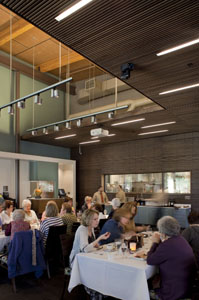A Culinary Classroom in the Central Oregon Woods
31 January 2013
 Cascade Culinary Institute builds a new culinary center whose physical and spatial attributes meld perfectly with its natural surroundings, facilitating student learning and the successful collaboration of education and community.
Cascade Culinary Institute builds a new culinary center whose physical and spatial attributes meld perfectly with its natural surroundings, facilitating student learning and the successful collaboration of education and community.
Located on the perimeter of the Central Oregon Community College (COCC) campus in Bend, Cascade Culinary Institute’s new Jungers Culinary Center is the anchor for a future mixed-use development, providing academic and commercial opportunities for the college and its students.
Portland-based Yost Grube Hall (YGH) Architecture collaborated with nationally recognized culinary and kitchen-design professionals to analyze the academic program and then develop a new curriculum and facility to support it. The new 15,000-sq.-ft. building reflects the college’s partnership with the region’s leading hospitality establishments and their staffs, resulting in a flexible facility program that will accommodate the culinary school’s needs for the next five to 10 years.
Equipped with all the spaces a culinary program would need—kitchens, dining spaces and a library—the Jungers Culinary Center is designed to embrace the natural beauty of central Oregon. Nestled among densely wooded Ponderosa pines, the center emerges from its rocky site with an exposed concrete base. It greets visitors with glass expanses beneath a wooden shed roof canopy. The building’s transparent main lobby, dining room and indoor/outdoor fireplace combine to create an inviting grand front porch that strengthens the connection between interior learning spaces and outdoor community areas.
Inspired by a simple cottage in the woods, the building ultimately reflects the culture of the community. The cottage concept is a guide for the design’s use of simple forms, construction methods and use of regionally sourced materials.
For example, central Oregon’s active outdoor lifestyle is emphasized by the center’s outdoor cooking and dining area, which is further amplified by its use of local wood and stone. The building massing is rectangular volumes captured below the plane of its low-sloped shed roof. The building materials retain a careful interplay of contrasts—the warmth and lightness of wood against the cool mass and strength of concrete; the transparency of glass adjacent to the textural qualities of cedar shingles and horizontal cedar siding. Emerging between these subtle contrasts is an equally subtle steel support structure that lends itself to balancing the materials.
Wood is the principal material of the building. It is used as the primary structure and as a finish material. Views from inside and outside the building continuously highlight the applications of wood throughout the project. Exposed wood structure, ceilings, soffits and select slatted walls embellish the cozy cottage motif while pointedly juxtaposing wood finishes with concrete, steel, glass and the vibrant wall accent color where display cases highlight students’ work.
The main lobby is simple and modestly elegant. Finished on the exterior by cedar shingle siding and glass walls, the interior’s polished concrete floor gives way to a small culinary library wrapped in dark wood slats, wood panels and glass, making it a focal point in the overall lobby space. The library houses community-donated culinary books and computer work stations.
Adjacent to the lobby, the main dining room is designed to be flexible while maintaining its intimacy for dining and learning experiences. Located under a 25-foot-tall roof, the sense of coziness is achieved by lowering a ceiling plane of dark wooden slats. The indoor/outdoor fire place and an adjacent executive dining room each provide additional warmth and comfort. The executive dining space, clad in board-formed concrete, can be opened up to the main room by way of operable wood and glass doors.
The “Central Hall” is the building’s main circulation and doubles as a flexible gathering space used for art exhibits, culinary displays and casual dining. The south-facing clerestory windows allow constantly changing daylight into the space. The Douglas fir roof joists are bathed in this changing light as they span the hallway in a repetitive and rhythmic pattern. The Central Hall connects the offices and building service areas on the south to all of the teaching kitchens on the north.
The instructional kitchen, demonstration theater and dining lab were designed to be multipurpose spaces, providing both academic and community use during a typical college day. To emphasize COCC’s academic mission of “learning on display,” all instructional spaces have glass entrances from the Central Hall.
For more info on Cascade Culinary Institute’s Jungers Culinary Center, visit www.cocc.edu/Cascade-Culinary-Institute.
Photo: Adjacent to the lobby, the main dining room at Jungers Culinary Center is designed to be flexible while maintaining its intimacy for dining and learning experiences.
